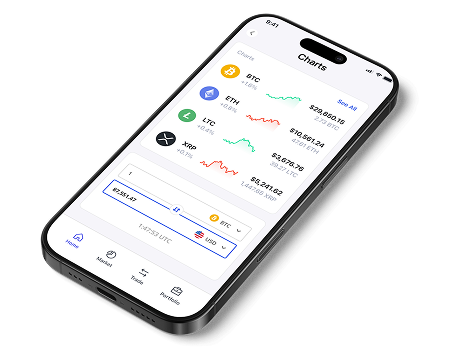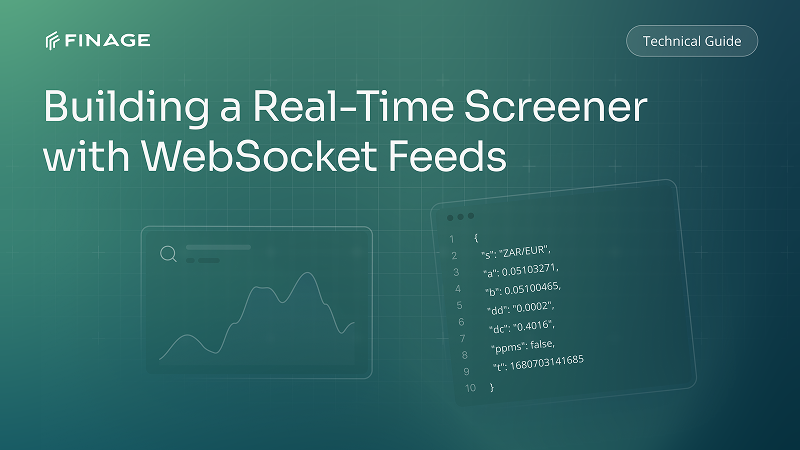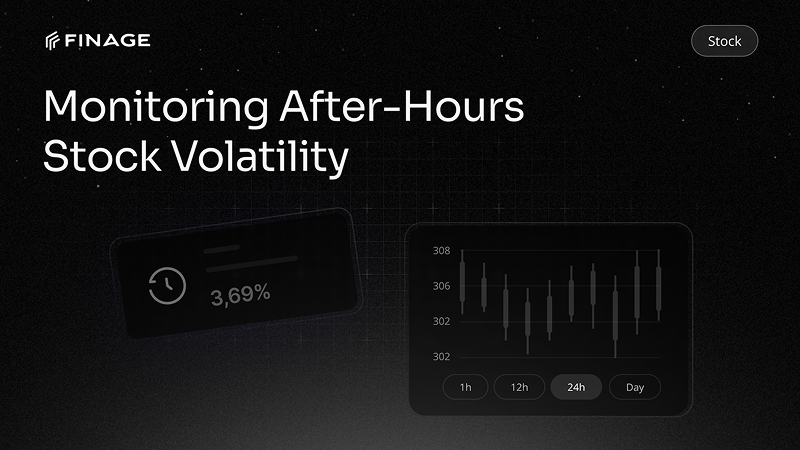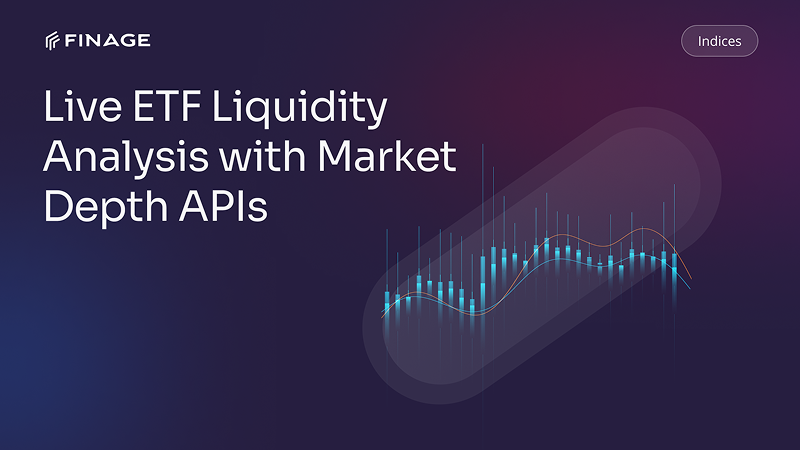How to Monitor Currency Volatility in Real Time?
11 min read • August 14, 2025

Introduction
In the fast-moving forex market, having access to an accurate currency volatility API can be the difference between identifying profitable opportunities and missing them entirely. Volatility, the rate at which currency prices move up or down, is one of the most important indicators for traders, risk managers, and fintech platforms. It signals market sentiment, highlights trading opportunities, and informs hedging strategies.
Monitoring volatility in real time requires more than just price updates. It involves processing live exchange rates, analyzing market fluctuations, and presenting insights in a way that allows users to act quickly. For developers and fintech teams, the right currency volatility API delivers these insights with speed, precision, and reliability.
With Finage, platforms can access ultra-low-latency market data, historical context, and volatility analytics in a single, developer-friendly integration. In this article, we’ll break down how to monitor currency volatility effectively, the role of APIs in this process, and what features to look for when building real-time monitoring tools.
Table of Contents
- Understanding Currency Volatility and Its Importance
- How Currency Volatility Is Measured
- The Role of APIs in Real-Time Volatility Monitoring
- Essential Features of a Currency Volatility API
- Technical Considerations for Accuracy and Speed
- How Finage Enables Real-Time Currency Volatility Monitoring
- Final Thoughts
1. Understanding Currency Volatility and Its Importance
Currency volatility refers to the speed and magnitude of price changes in the foreign exchange (forex) market. It reflects how much and how quickly exchange rates move over a given period. High volatility indicates frequent and significant price swings, while low volatility means prices are relatively stable.
- For traders, volatility represents both opportunity and risk:
Opportunity because large price movements can create profitable trading setups.
Risk because sudden, unexpected shifts can trigger losses if positions aren’t managed carefully.
- Volatility is influenced by a variety of factors, including:
Economic events such as GDP releases, employment reports, and central bank decisions.
Geopolitical developments, like trade negotiations or political instability.
Market sentiment is driven by investor confidence or fear.
Understanding volatility is essential for different market participants:
Day traders use it to identify high-potential short-term trades.
Hedgers track it to protect against adverse currency moves.
Portfolio managers incorporate it into risk models to ensure balanced exposure across assets.
By monitoring volatility in real time, traders and platforms can react faster to emerging trends, adjust strategies instantly, and reduce the risk of being caught off guard by sharp market moves.
2. How Currency Volatility Is Measured
Volatility in currency markets is a statistical measure of how much exchange rates fluctuate over a given time frame. While traders can “see” price swings on a chart, quantifying volatility allows for systematic analysis, comparisons between currency pairs, and the automation of risk controls.
Historical Volatility (Statistical Approach)
Historical volatility calculates the standard deviation of past price movements over a defined period, for example, 20 trading days. This approach looks backward, analyzing closing prices to determine how widely they have varied.
Strengths: Objective, easy to compute, and widely used in risk models.
Limitations: It reflects the past and may not accurately predict future volatility, especially after sudden market shocks.
Implied Volatility (Market Expectation Approach)
Implied volatility is derived from the prices of options on currency pairs. It reflects the market’s expectation of future price movement, as implied by current option premiums.
Strengths: Forward-looking and useful for anticipating market sentiment shifts.
Limitations: Dependent on the liquidity and accuracy of options market pricing.
Average True Range (ATR)
ATR measures volatility by calculating the average range between the high and low prices of a currency pair, adjusted for any gaps between sessions.
Strengths: Effective for identifying daily volatility levels, especially in spot forex trading.
Limitations: Does not indicate direction, only the magnitude of movement.
Real-Time Tick Data Analysis
For high-frequency or intraday traders, volatility can be tracked using tick-by-tick price changes. This method measures how often and by how much prices change in real time, providing instant feedback on current market conditions.
Strengths: Most responsive to sudden market moves.
Limitations: Requires high-quality, low-latency data feeds to avoid distortions.
Why APIs Matter Here
A currency volatility API can deliver pre-calculated volatility metrics (historical, implied, or real-time) or provide raw market data for platforms to compute volatility in-house. This flexibility is crucial for tailoring monitoring tools to different trading styles and risk profiles.
3. The Role of APIs in Real-Time Volatility Monitoring
In the fast-paced forex market, volatility can shift in seconds. An API acts as the delivery channel that turns raw market data into actionable insights, making it possible to track these changes without manual intervention. For developers and fintech platforms, a currency volatility API is the backbone that ensures timely, consistent, and accurate volatility data reaches the end user.
Bridging Data Sources and Applications
A volatility API aggregates data from multiple sources, including live exchange rates, historical datasets, and derivative markets, then formats it into a standardized structure. This eliminates the complexity of integrating separate feeds and ensures every volatility reading is consistent across platforms.
Enabling Real-Time Calculations
Some APIs provide pre-calculated volatility metrics like historical volatility, implied volatility, or average true range, while others supply raw tick data so platforms can compute custom volatility indicators on the fly. This flexibility allows applications to serve both retail traders who want quick insights and institutional users who prefer custom models.
Reducing Latency for Time-Sensitive Decisions
Volatility spikes often present short-lived trading opportunities. A well-optimized API uses low-latency delivery methods, typically WebSockets for streaming, so updates are pushed instantly rather than fetched in delayed batches.
Supporting Automation and Alerts
By integrating directly with trading systems or alert engines, APIs make it possible to trigger automated responses when volatility crosses a threshold. For example, a trader could receive an instant push notification when EUR/USD volatility exceeds its 30-day average.
Ensuring Data Reliability Under Stress
During major market events, traffic to volatility APIs can surge. High-quality APIs are built with load balancing, redundancy, and failover systems to maintain uptime and accuracy even under extreme demand.
Finage’s API Advantage
Finage delivers both raw market data and pre-computed volatility analytics via ultra-low-latency APIs. This makes it possible for developers to integrate real-time volatility monitoring into platforms with minimal setup time while ensuring accuracy and speed remain consistent under all market conditions.
4. Essential Features of a Currency Volatility API
Not all APIs are built the same. To effectively track volatility in the forex market, a currency volatility API must provide both technical robustness and analytical flexibility. The right combination of features will determine whether the API simply delivers raw numbers or enables actionable, insight-driven trading decisions.
Real-Time Volatility Metrics
The API should deliver instant volatility readings for key currency pairs, updated with minimal latency. This is essential for traders who act on short-lived market conditions, where even a one-second delay can impact execution quality.
Multiple Calculation Methods
Different traders rely on different definitions of volatility. An ideal API should offer:
Historical volatility for backward-looking analysis.
Implied volatility for forward-looking market expectations.
Intraday volatility for short-term strategy adjustments.
Customizable Timeframes
Being able to query volatility over specific time intervals, such as 1-minute, 15-minute, daily, or monthly, allows platforms to serve multiple trading styles, from scalpers to long-term portfolio managers.
Multi-Currency Pair Coverage
Forex volatility is interconnected. An effective API should allow monitoring of multiple currency pairs simultaneously, supporting both major and exotic pairs to give traders a complete view of market dynamics.
Historical Data Access
Access to historical volatility data helps traders backtest strategies and compare current conditions against past market events. This is also valuable for risk modeling and long-term portfolio planning.
Alerts and Threshold Triggers
An advanced API should support triggers for when volatility exceeds or falls below certain thresholds. This allows traders and risk managers to automate responses or receive instant notifications during unusual market activity.
Reliability Under Load
Major economic announcements can cause traffic spikes and volatility surges at the same time. A reliable API must maintain uptime, accuracy, and low latency during these high-demand periods.
Why It Matters
Without these features, a currency volatility API risks being incomplete, either too slow, too narrow in scope, or lacking the analytical depth traders need. A well-rounded API bridges the gap between raw market data and actionable decision-making tools.
5. Technical Considerations for Accuracy and Speed
A currency volatility API is only as good as the infrastructure behind it. In fast-moving forex markets, accuracy and speed must be maintained under all conditions, including during major economic announcements when volatility and demand spike simultaneously.
Low-Latency Architecture
Reducing the time between data generation and delivery is critical. This is typically achieved by:
- Co-locating servers near major exchange and liquidity provider data centers.
- Using WebSocket streaming for continuous delivery rather than periodic polling.
- Optimizing data serialization formats (like Protobuf or JSON variants) for faster transmission.
Multi-Source Data Verification
Relying on a single source can lead to inaccuracies if that feed experiences errors. High-quality APIs cross-check incoming volatility data against multiple independent sources to ensure consistency before it’s sent to clients.
Real-Time Error Handling
When data anomalies occur, for example, sudden volatility spikes caused by erroneous price ticks, automated filters and validation rules should detect and correct them instantly, without human intervention.
Load Balancing and Scalability
Forex market events can create sudden surges in API requests. Load balancing across distributed servers ensures stable performance under peak demand, while auto-scaling infrastructure dynamically adds resources when needed.
Historical Alignment for Accuracy
Real-time volatility metrics should remain consistent with historical datasets. This prevents discrepancies between current readings and long-term volatility patterns, which could otherwise distort analytics or trading signals.
Uptime and Redundancy
Mission-critical applications need APIs with near-100% uptime. Redundant systems and failover mechanisms ensure uninterrupted service even if one server, feed, or region experiences issues.
Finage’s Approach
Finage applies these principles by combining co-located low-latency servers, multi-source verification, and robust failover systems. This ensures volatility metrics are accurate, consistent, and delivered in milliseconds, even during the busiest trading sessions.
6. How Finage Enables Real-Time Currency Volatility Monitoring
Monitoring currency volatility effectively requires a combination of reliable data sources, fast delivery, and robust infrastructure that can sustain accuracy under any market conditions. Finage is designed with these exact needs in mind, offering APIs that make it easier for developers to build responsive, dependable, and data-rich forex applications.
Multi-Source Verified Data
Finage aggregates forex market data from multiple trusted sources, ensuring volatility readings are cross-checked in real time. This multi-source approach reduces the risk of inaccuracies from any single feed and provides greater confidence in the data.
Ultra-Low-Latency Delivery
Finage uses co-located servers and WebSocket streaming to deliver updates in milliseconds. This speed is critical for capturing and acting on volatility spikes as they happen, without missing short-lived opportunities.
Pre-Computed and Customizable Volatility Metrics
Developers can access both pre-calculated volatility indicators and the raw market data needed to compute custom metrics. This flexibility allows platforms to tailor volatility tracking to their users’ specific trading strategies.
Scalable, High-Uptime Infrastructure
Whether serving thousands of retail traders or institutional clients, Finage’s architecture is built for scalability and stability. Load balancing and redundant systems ensure performance remains consistent during high-demand periods, such as central bank announcements.
Built-In Normalization and API Flexibility
Finage normalizes currency pair identifiers, timestamps, and data formats across feeds. This ensures consistent, ready-to-use data without additional processing, making integration smoother and faster for development teams.
Why This Matters for Traders and Developers
By combining speed, accuracy, and flexibility, Finage’s currency volatility API allows fintech platforms to offer users volatility insights they can trust. It’s an end-to-end solution that eliminates the heavy lifting of sourcing, verifying, and delivering real-time forex volatility data.
Final Thoughts
In the forex market, volatility can change within seconds, creating both opportunities and risks. Accurately tracking these movements requires more than watching price charts; it demands a system that delivers reliable, real-time metrics directly to the traders and analysts who need them. A well-designed currency volatility API makes this possible by combining verified data sources, low-latency delivery, and analytical flexibility.
From measuring volatility through historical, implied, and intraday methods to ensuring precision with multi-source validation and scalable infrastructure, the right API turns raw market noise into clear, actionable insight. This capability is essential for building trading tools, risk management systems, and analytics platforms that can keep pace with the market’s speed.
Finage provides developers with the tools to achieve this, offering ultra-low-latency streaming, comprehensive currency coverage, and pre-computed or customizable volatility metrics. It’s an all-in-one solution designed to help fintech platforms deliver trustworthy volatility insights at scale.
Start your free trial with Finage today and experience how accurate, real-time currency volatility data can transform your trading or analytics platform.
Relevant Asked Questions
- What is the best way to monitor forex volatility in real time?
The best way to monitor forex volatility in real time is by using a low-latency, multi-source-verified API that delivers both raw tick data and pre-calculated volatility metrics. Finage offers this through WebSocket streaming and historical coverage for major and exotic currency pairs.
- How do APIs help in tracking currency volatility accurately?
APIs streamline the delivery of real-time volatility data by aggregating exchange rates, filtering anomalies, and pushing updates instantly. Finage’s API delivers metrics like ATR, implied volatility, and historical deviation—ideal for platforms needing speed, precision, and customization.
- Which features should a good currency volatility API include?
A strong volatility API should support multiple calculation methods, customizable timeframes, real-time streaming, historical access, and alert triggers. Finage’s API includes all of these, ensuring developers can build tailored volatility tools for retail and institutional users alike.
Claim Your Free API Key Today
Access stock, forex and crypto market data with a free API key—no credit card required.

Stay Informed, Stay Ahead
Finage Blog: Data-Driven Insights & Ideas
Discover company news, announcements, updates, guides and more


